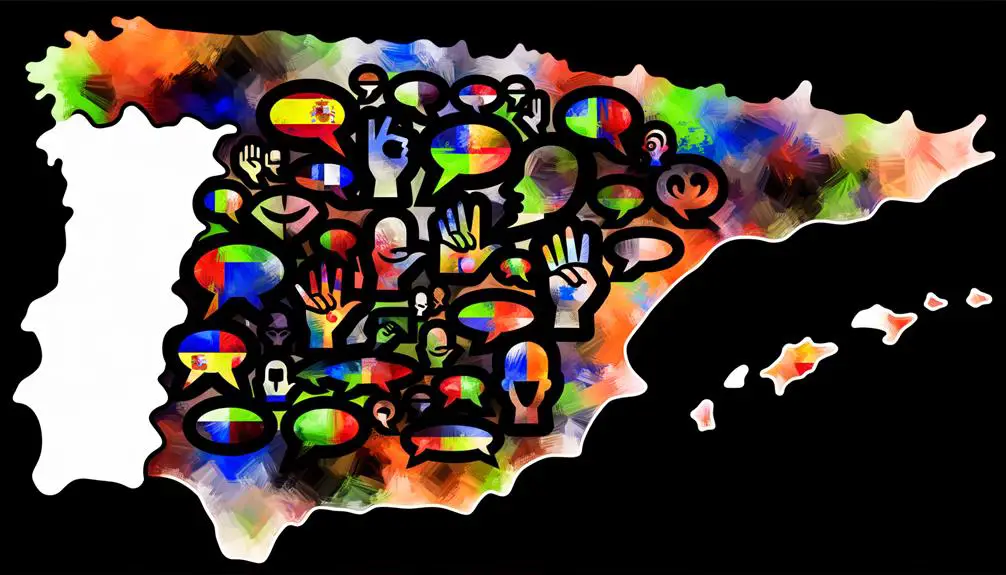You're looking for a concise way to express 'enough' in Spanish slang. In Spain, 'Basta ya!' means 'enough already' and can be both serious and lighthearted. In Argentina, 'Che' is a casual filler word, while 'alcanza' means 'reach' or 'be enough'. Chileans use 'Ya está bueno' for 'that's enough', while Colombians exclaim 'Hasta ahí!' to convey excitement or frustration. In Mexico, 'Eso es todo!' marks the end of a conversation. Mastering these nuances will help you convey boundaries and build connections in Latin America. As you explore further, you'll uncover more regional expressions and refine your cultural understanding.
Basta Ya: The Spanish Way

You'll often hear Spaniards exclaim 'Basta ya!' in everyday conversations, a phrase that's become an integral part of the Spanish way of life. In Spanish culture, 'basta ya' is more than just a phrase – it's an expression of frustration, exhaustion, or even playful teasing. Literally translating to 'enough already,' it's used to convey that a situation has reached its limit. You might hear it in response to a friend's constant complaining or when someone's had enough of a tedious task.
Pay attention to the nuances of language, and you'll notice that 'basta ya' can be both serious and lighthearted, depending on the tone and context. In Spanish culture, this phrase is a reflection of the relaxed, expressive nature of the people. It's not uncommon to hear 'basta ya' in casual conversations, TV shows, or even in written texts.
Che, Alcanza in Argentinean Slang
In Argentinean slang, the phrase 'che' is an integral part of everyday conversations, often used as a filler word similar to 'like' or 'um' in English, while 'alcanza' is a versatile verb that can mean 'reach,' 'get,' or 'be enough.'
You'll frequently hear 'che' in casual conversations among friends, family, or even strangers on the street. It's a unique aspect of Argentine culture that sets it apart from other Spanish-speaking countries. The origins of 'che' are unclear, but it's believed to have originated from the Italian 'ci' or the Venetian 'çe,' brought over by Italian immigrants in the late 19th century.
Over time, Argentine slang has evolved to incorporate 'che' in various contexts. You might hear it in daily life, such as in phrases like 'Che, cómo estás?' (Hey, how are you?) or 'Che, alcanza' (Hey, that's enough). While 'alcanza' has limitations in its usage, 'che' has many variations, like 'boludo' or 'pibe,' which hold significant cultural significance in Argentine society.
Understanding 'che' and 'alcanza' will give you a deeper appreciation for Argentine culture and its nuances.
Dejá, Ya Está Bueno in Chile

While exploring everyday conversations in Chile, you'll likely come across the phrases 'dejá' and 'ya está bueno,' which serve as essential expressions in informal settings. These phrases are deeply rooted in Chilean culture, reflecting the laid-back and casual nature of the locals.
'Dejá' is often used to convey a sense of 'let it go' or 'forget about it,' while 'ya está bueno' means 'that's enough' or 'it's okay.' These phrases are frequently used in everyday conversations, especially among friends and family.
As you dive deeper into Chilean slang, you'll notice that these expressions are a result of the country's unique slang evolution. Chilean Spanish has been shaped by the country's history, geography, and cultural influences.
The use of 'dejá' and 'ya está bueno' is a reflection of the relaxed and easy-going nature of Chileans, who value simplicity and humility. By incorporating these phrases into your conversations, you'll be able to connect with locals on a deeper level and gain a better understanding of Chilean culture.
Hasta Ahí! in Colombian Streets
Colombian streets resonate with the energetic phrase 'Hasta ahí!', which serves as a versatile expression of excitement, surprise, or even frustration. You'll often hear it exclaimed by locals in response to surprising news, an impressive achievement, or a thrilling experience.
This phrase is deeply ingrained in Colombian culture, and you'll frequently come across it in everyday conversations, street phrases, and even in music lyrics.
As you navigate the vibrant streets of Colombia, you'll notice that 'Hasta ahí!' is more than just an expression – it's a way of life. It's a phrase that embodies the country's lively spirit and warm hospitality. When you hear it, you know you're in for a treat, whether it's a thrilling adventure, a lively celebration, or a heartwarming moment.
Incorporate 'Hasta ahí!' into your Colombian expressions, and you'll instantly connect with the locals. It's a phrase that transcends language barriers, conveying emotions and excitement in a way that's unique to Colombian culture.
Eso Es Todo! in Mexican Lingo

As you shift your focus from Colombia to Mexico, you'll discover that the phrase 'Eso Es Todo!' is a staple in Mexican lingo, serving as a casual way to convey 'that's it' or 'that's all.' This phrase is often used to signal the end of a conversation, a task, or an activity.
When a Mexican says 'Eso Es Todo!', they're implying that there's nothing more to add, discuss, or do. In Mexican culture, 'Eso Es Todo!' is more than just a phrase – it's a reflection of the cultural nuances that value simplicity and directness. Mexicans often prioritize getting straight to the point, and this phrase embodies that spirit.
When you're chatting with a Mexican friend, and they say 'Eso Es Todo!', you know the conversation is wrapping up, and it's time to move on. Using 'Eso Es Todo!' in your interactions with Mexicans will show that you're making an effort to understand their cultural nuances and speak their language. It's a great way to build connections and show respect for their customs.
Parar, Dejar, and Other Options
In Mexico, you'll often hear variations of 'to stop' or 'to quit' in everyday conversations, with options like parar, dejar, and other phrases that can be used in different contexts. These phrases are essential to know when communicating with locals or negotiating with vendors.
For instance, if you want to tell someone to stop doing something, you can say 'para ya' or 'stop already.' If you want to ask someone to pause, you can say 'pause, por favor' or simply 'pause please.'
Dejar is another common verb that means 'to leave' or 'to quit,' but it can also mean 'to stop' in certain contexts. For example, if you want to tell someone to stop doing something annoying, you can say 'deja de hacer eso' or 'stop doing that.' Other options include 'cortar' which means 'to cut' but can also mean 'to stop' in certain situations.
Understanding the nuances of these phrases will help you navigate everyday conversations with confidence.
Enough in Different Regional Accents

You'll encounter variations of 'enough' in different regional accents and dialects, with some phrases being more common in certain areas than others. For instance, in Mexico, you might hear 'ya buena' or 'ya basta' to convey the idea of 'enough.'
In Argentina, Uruguay, and parts of Chile, 'che' is often used to emphasize that something is sufficient, as in 'che, ya es suficiente.' In Latin American variations, 'hasta aquí' or 'hasta ya' are commonly used to mean 'enough is enough.'
Regional dialects also play a significant role in shaping the way people express 'enough.' In Spain, 'bastante' is a common way to say 'enough,' but in some regions, like Andalusia, 'hasta aquí nomás' is preferred. In Central America, 'ya es bastante' or 'ya es suficiente' are widely used.
Understanding these regional nuances can help you better communicate with locals and avoid misunderstandings. By recognizing the different expressions of 'enough,' you'll be able to navigate everyday conversations with more confidence and precision.
Formal Vs. Informal Expressions
Your command of 'enough' in Spanish will also depend on the level of formality you want to convey, as different expressions are used in formal and informal settings.
When speaking in a formal tone, you'll want to use expressions that convey respect and professionalism. For instance, in formal writing or business communications, you might use 'bastante' or 'suficiente' to convey the idea of 'enough.' These words are more formal and polished, making them suitable for formal situations.
On the other hand, in informal settings, you can opt for more casual expressions like 'bastante' or 'harto' to convey a more relaxed tone. Cultural nuances play a significant role here, as the level of formality can vary greatly depending on the region, social context, and personal relationships. Being aware of these nuances will help you navigate different social situations with confidence.
Using Enough in Everyday Conversations

Mastering the nuances of 'enough' in Spanish can greatly enhance your everyday conversations, allowing you to express yourself more accurately and confidently in a variety of social situations.
When you're chatting with friends or family, being able to convey your everyday limits and casual boundaries is essential. For instance, you might say 'Me cansé' (I'm tired) to signal that you've had enough of an activity.
Similarly, you can use 'Basta' (enough) to establish a clear boundary in a casual setting. Imagine being able to tell your friend 'Basta de hablar de eso' (enough talking about that), and they'll understand that you're ready to move on to a different topic.
Mastering Enough in Latin American Culture
Understanding the cultural nuances of social interactions in Latin America is crucial to navigating complex situations with confidence. Recognizing the subtleties of 'enough' can be a game-changer in building stronger relationships and avoiding unintentional offense. Mastering 'enough' in everyday conversations can help you show your willingness to accommodate others' needs.
However, acknowledging that language barriers can lead to misunderstandings is key. In some Latin American countries, saying 'bastante' (enough) might be perceived as abrupt or rude. To prevent this, focus on grasping the cultural nuances behind the language. For example, in Mexico, using 'suficiente' (enough) in a polite tone can greatly contribute to building trust.
Frequently Asked Questions
Can I Use "Basta" in Both Formal and Informal Situations?
When deciding whether to use 'basta' in a conversation, consider the tone you want to convey. You'll want to use 'basta' in informal situations with friends or family, as it's a casual way to say 'enough.'
However, in formal situations or when speaking with authority figures, it's better to opt for a more polite phrase to maintain a respectful tone. Be mindful of cultural differences and adjust your language accordingly to avoid unintentionally coming across as rude or dismissive.
Is "Che" Only Used in Argentinean Slang for "Enough"?
As you navigate the labyrinth of Latin American dialects, you'll find that 'che' isn't exclusive to Argentinean slang. Think of language as a rich tapestry, woven with threads from diverse cultures.
In reality, 'che' is also used in Uruguayan and Bolivian dialects, albeit with varying frequencies. So, while 'che' might be more ubiquitous in Argentina, it's not unique to that region.
How Do I Respond When Someone Says "Ya Está" in Chile?
When someone says 'ya estás' in Chile, you're likely being told you've had enough of something, like food or drink.
Respond with a simple 'gracias' to acknowledge their concern.
Be mindful of cultural nuances, as this phrase is an everyday expression of consideration in Chilean culture.
You can also ask '¿Quieres más?' (Do you want more?) to show appreciation for their thoughtfulness.
Is "Hasta Ahí" Only Used in Colombian Streets or Elsewhere Too?
You're wondering if 'hasta ahí' is exclusive to Colombian streets. Let's set the record straight – it's not a Colombian dialect monopoly!
While it's indeed popular in Colombia, you'll also hear 'hasta ahí' in other Latin American countries, like Venezuela and Ecuador.
It sets a limit, implying 'up to that point' or 'that's enough.'
Are There Regional Accents Where "Eso Es Todo" Is Not Commonly Used?
You're wondering if 'eso es todo' is universally used across Latin America. The answer is no. Regional dialects play a significant role in shaping local expressions.
In some Latin American variations, 'eso es todo' mightn't be as commonly used. For instance, in some Caribbean coastal regions, 'ya está' or 'listo' might be preferred over 'eso es todo' to convey 'that's all.'







